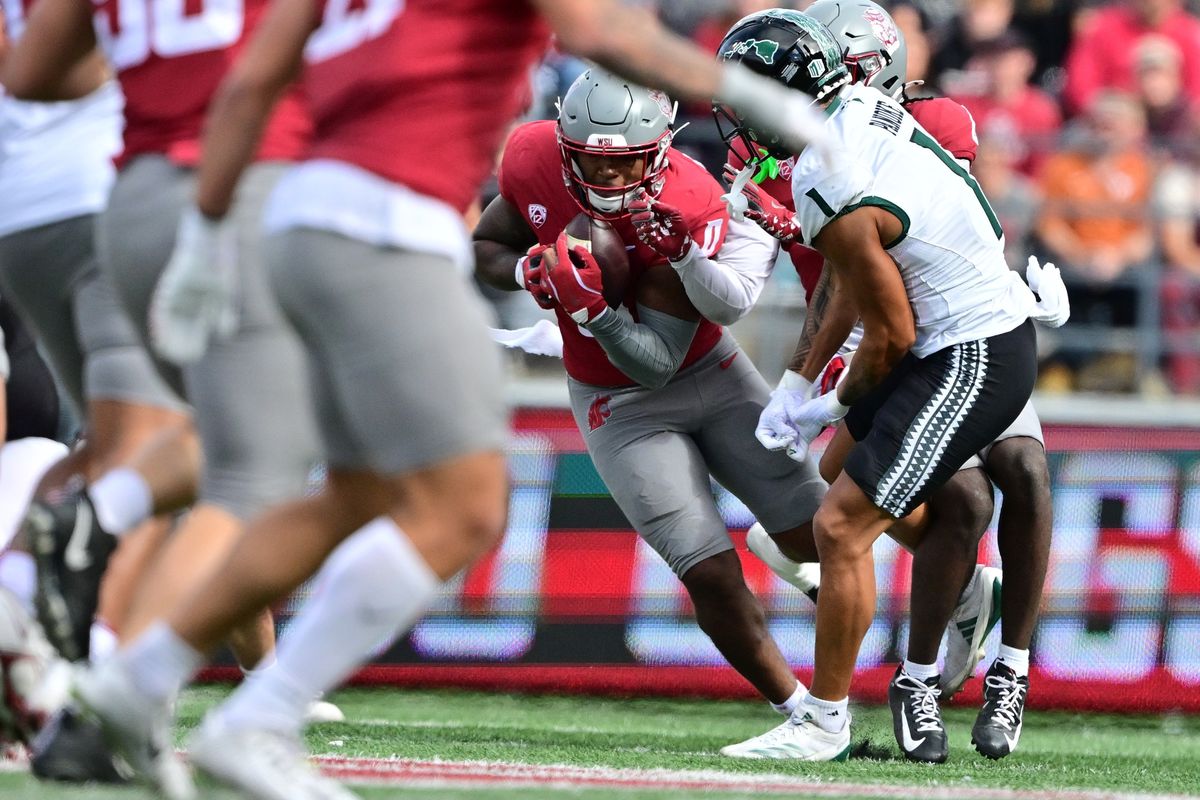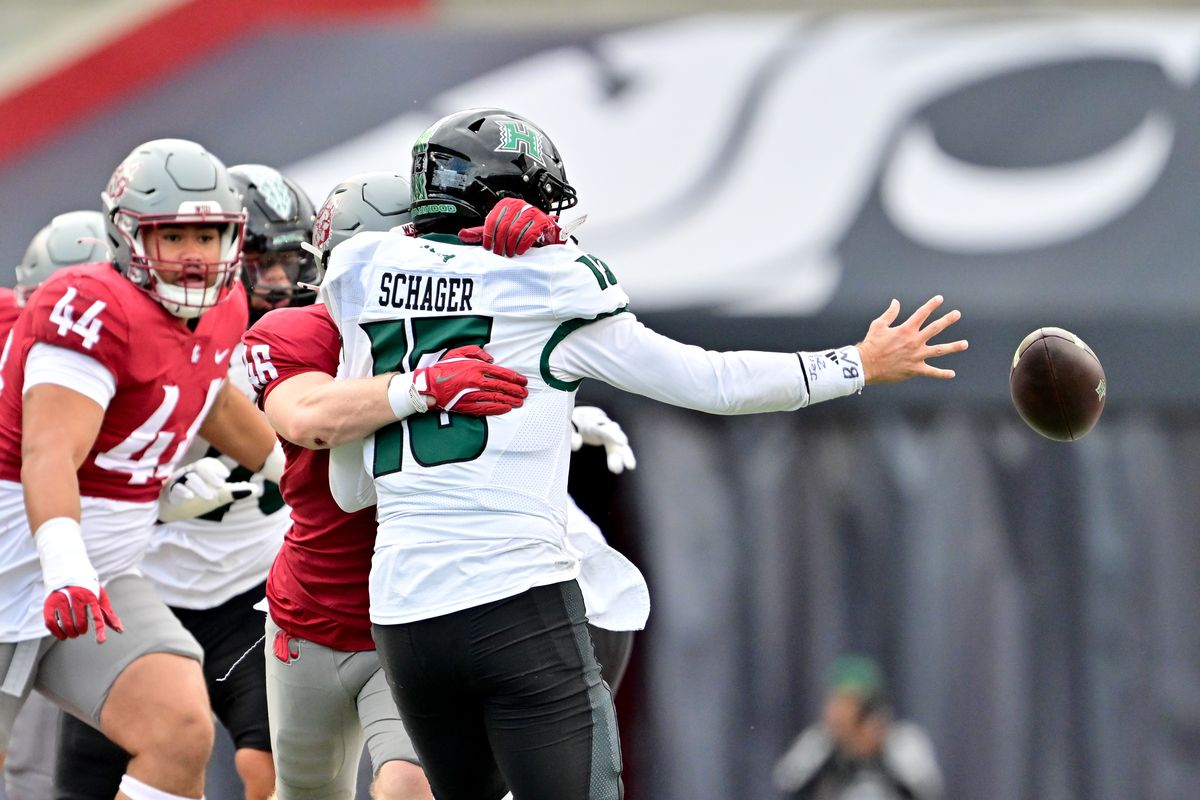‘It’s huge for us’: The numbers and the approach behind WSU’s success on the turnover front
Washington State linebacker Taariq Al-Uqdah intercepts a pass from Hawaii quarterback Brayden Schager during the first half Saturday at Gesa Field in Pullman. (Tyler Tjomsland/The Spokesman-Review)
PULLMAN – On the sideline in real time and watching the tape later on, Washington State coach Jake Dickert could tell Jamorri Colson could have given up on the play.
It was early in the second quarter of WSU’s 42-10 win over Hawaii last weekend, and after the Rainbow Warriors completed a pass over the middle, Colson wasn’t involved in the play. The Cougars’ cornerback was on the other end of the field, guarding a different receiver, and his teammates looked to be in position to make the tackle.
Instead, Colson left his assignment, surged toward UH receiver Nick Cenacle, lowered his shoulder and delivered a hit to jar the ball loose. WSU nickelback Kapena Gushiken leapt on the football, recovering the fumble. The Cougars took over around midfield.
“What a hit that was,” Dickert said. “You get yourself in a position where the ball finds you if you play with tons of energy. I think lately, you really feel that. Great team football for our offense to score those. So that was huge in this last football game.”
That hit resulted in one of the Cougars’ three takeaways in the game, including a forced fumble courtesy of linebacker Parker McKenna and an interception from fellow linebacker Buddah Al-Uqdah, his first of the season. It brought WSU’s takeaway total to 14, tied for No. 6 nationally, underscoring how much Dickert and the Cougars pay attention to forcing turnovers.
WSU has nine interceptions and has recovered five fumbles. Redshirt freshman Ethan O’Connor leads the way with three picks, safety Tyson Durant has two, and Gushiken, Al-Uqdah, cornerback Steve Hall and linebacker Kyle Thornton have one apiece.
Five players have recovered one fumble apiece: Al-Uqdah, Gushiken, Durant, linebacker Wesley Steiner and defensive tackle Bryson Lamb. The Cougars have forced eight fumbles, recovering five.
Dickert said that’s no accident. He’s big on analytics, which he said show that in the past five years, if a team can reach 20 takeaways in one season, it can register eight wins or more. On offense, he said, if a team loses just one turnover per game and 12 for the season, “that’s fantastic football.”
WSU is on track in both departments, Dickert said. On offense, the Cougars have lost seven turnovers in seven games, an average of one per game. On defense, they’re averaging 2.2 takeaways per game, putting them on track for about 26, easily clearing Dickert’s benchmark of 20.
Ahead of WSU’s road test against San Diego State this weekend, that has given the Cougars a turnover margin of plus-7, tied for No. 7 nationally. It’s a hair shy of the standard Dickert wants to reach – he wants to get to plus-8, which “leads to nine-plus wins,” he said – but it does indicate that on the turnover front, Washington State is headed in the direction Dickert wants to go.
If WSU reaches 26 takeaways, it would be the program’s most since 2021, when the defensive-minded Dickert took over head coaching duties midway through the season. That year, the Cougars had 29 takeaways, good for No. 5 nationally, earning seven wins along the way.
Since then, WSU had 21 takeaways in 2022 (No. 35 nationally) and 15 in 2023 (No. 97 nationally).
Whether the Cougs are succeeding at it, this much is clear: Dickert and his staff make a point about forcing turnovers. The right numbers lead to more wins, they have figured out, but there’s also the more obvious reality, which is that when the Cougs have turned opponents over, they’ve generated real momentum – which they’ve done well to parlay into points.
This fall, WSU has turned 14 turnovers into 60 points. Last weekend against Hawaii, the Cougs turned three into 21 points. Against Fresno State, they turned two turnovers into six points – all of which came on O’Connor’s go-ahead interception return for touchdown in the fourth quarter. They turned over San Jose State three times for 14 points, including a critical pick from Thornton, and they turned over Texas Tech four times for 13 points.
“That creates a lot of momentum, which creates a lot of energy for us,” WSU edge rusher Syrus Webster said. “It’s definitely huge for us.”
More often than not, the Cougs are cashing in on that momentum. In regulation this season, WSU has started eight drives off a turnover. The Cougs have scored on six of those. Not only that, but they’re cashing in quickly, scoring in an average time of 1 minute , 3 seconds.
The Cougars aren’t looking to waste time when they generate a turnover. They’re looking to push the ball up the field, capitalizing on the energy they’ve just created, and they’re succeeding.
In the second quarter of WSU’s win over Texas Tech, after Al-Uqdah forced a fumble, recovered it and returned it to the Red Raiders’ 2-yard line, the Cougs needed only one play to score, getting a short touchdown burst from power back Djouvensky Schlenbaker.
In the same game, after O’Connor intercepted a pass and returned it to the Red Raiders’ 38-yard line, WSU only needed three plays to score. On the third, John Mateer dropped back and unfurled a deep pass into the corner of the end zone for Williams, who bobbled the ball and grabbed it for a touchdown, a 21-yard strike.
A week later, after Thornton had an interception in Washington State’s double-overtime win over San Jose State, the Cougs’ first play was a shot play, a 31-yard pass from Mateer to receiver Josh Meredith down the sideline. One play later, running back Dylan Paine punched in a 1-yard touchdown rush.
Last weekend against Hawaii, WSU did much of the same. Shortly after Colson caused a fumble, quarterback Mateer and the offense took the field. Their first play was their longest of the game, a 35-yard strike from Mateer to Williams, pushing WSU deep into Hawaii territory. Two plays later, Mateer hit tight end Cooper Mathers on a 9-yard touchdown pass.
The CW
In the turnover department, the Cougs are playing a numbers game. More often than not, they’re coming up aces.

